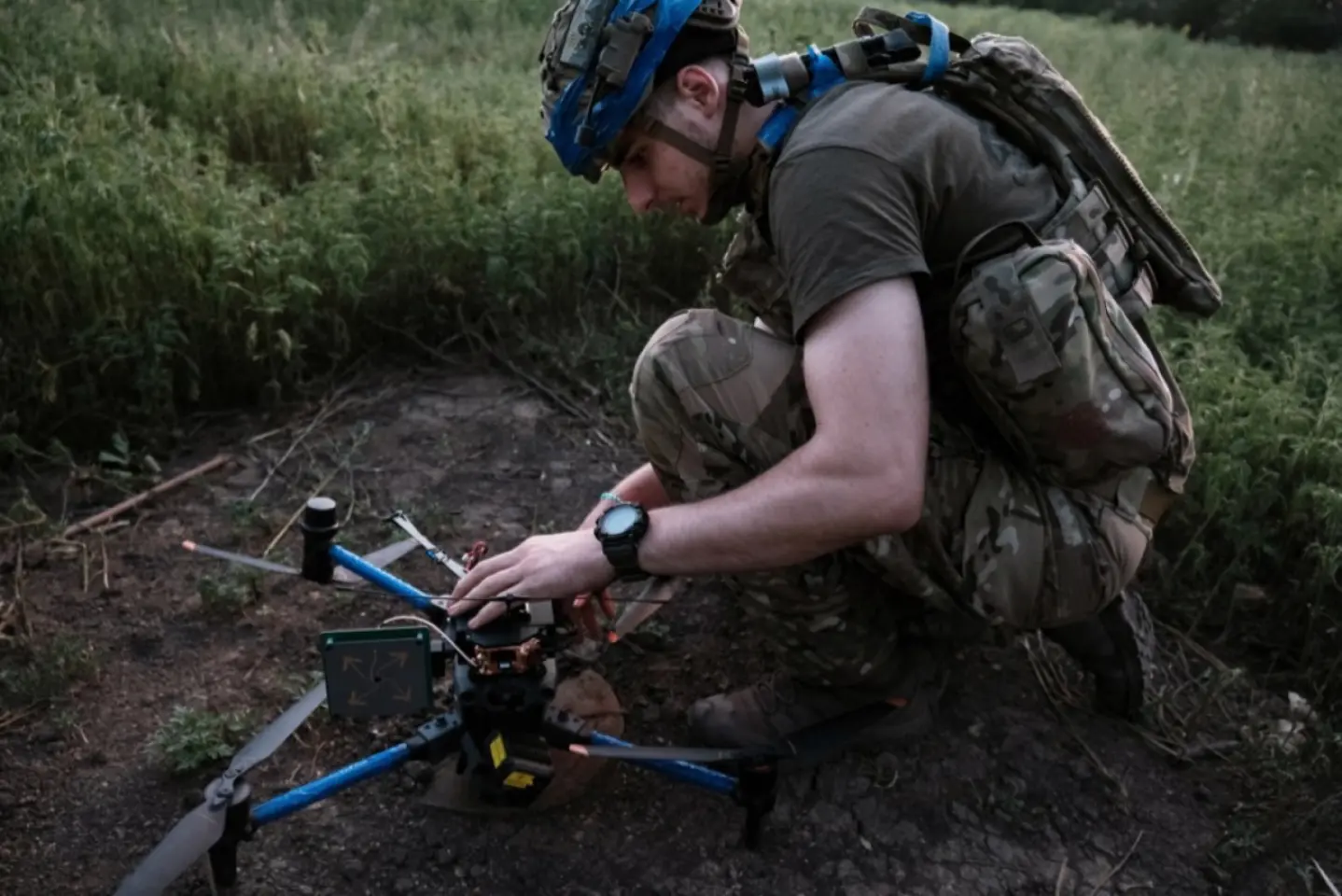
The war in Ukraine has shown that modern warfare is impossible without the involvement of drones. Both Russia in Ukraine have ramped up drone production – Ukraine’s output, for instance, increased by 900% during the past year, with a monthly capacity of over 200,000 unmanned aerial vehicles. Other nations have been taking note, including Russia’s neighbors, who are weary about the country’s aggressive stance.
Estonia is one of those neighbors and is seeking to increase both drone production and drone use by the military. Security expert Ilmar Raag, a member of the voluntary defence organisation Kaitseliit, and a participant in foreign military missions, told Veridica that while production is increasing, the armed forces are somewhat slower in fully introducing this new weapon:
"Theoretically, everything is fine. There are Estonian companies whose products are used in Ukraine, and these drones are fighting there. But the other side is that the introduction of this technology into the Estonian Defence Forces is, shall we say, at a rather early stage. Yes, the Estonian army makes wide use of various reconnaissance drones, but given that in Ukraine the real 'game-changers' have been small FPV attack drones, it creates a strange situation: these very same Estonian FPV drones are fighting in Ukraine, but in Estonia itself they have not yet been systematically deployed in the forces."
Preparation came late
In his opinion, Estonia's preparation in this regard has been somewhat late, although this year the Defence Forces launched a large-scale programme aimed at making a technological leap. Specialists have been hired to work both on drones and counter-drone measures, a so-called drone doctrine has been developed, and training courses have been initiated. The scale is illustrated, for example, by the fact that Tallinn University of Technology (TalTech) has created an educational programme that is now offered to high schools — for now, as part of a pilot project.
Estonia is not breaking new ground here: it is known that in Russia, both students and schoolchildren are involved in assembling attack drones — and it was recently reported that they are being recruited not only in Russia itself but also in Kazakhstan. The training provided at Estonia’s TalTech relates to civilian use — operating drones and building them; the military application, where explosives are mounted on drones and operators are taught how to deliver them to the enemy, is not part of the TalTech programme.
Drone production in Estonia itself, of course, cannot be compared to that of Ukraine or Russia — nor can its military budget. However, the drone industry is considered a promising sector. In May this year, it became known that the entrepreneurs behind the drone sales website droon.ee plan to launch a drone manufacturing plant in the Baltic States. For security reasons, it has not been disclosed whether the plant will be built in Estonia, Latvia, or Lithuania. It is planned that at the initial stage, the Meridein Grupp plant will be able to produce up to 2,000 drones per day. The company has already signed contracts for the supply of attack drones, bomber drones, and reconnaissance drones.
“We can currently produce various types of drones,” notes Ilmar Raag. One of the most well-known Estonian companies — Threod Systems — produces, in his estimation, very high-quality reconnaissance drones. “But they are intended for higher-level units, not for every company. There are also companies that produce various types of strike drones: FPV drones and ‘wings’ capable of flying longer distances. But their amount, unfortunately, is small. Therefore, we cannot yet say that in terms of strike capability — even in relative terms — we are anywhere close to Russia or Ukraine; definitely not,” Raag believes.
There is very close cooperation with Ukraine, which over the past year and a half has become Europe’s leader in drone production and military application. As Raag notes, drones from all Estonian manufacturers are fighting in Ukraine, which means they receive direct feedback from real combat units.
“Thus, they constantly have, if not the very latest, then some of the most up-to-date technical knowledge of the situation. A good example — this spring, Ukrainian drone instructors were present at the largest exercises of the Estonian Defence Forces. They didn’t just participate in demonstration battles; they showed exactly how they operate in Ukraine, and they were quite successful even against our units,” he says.
China is approached with caution
One of the associated issues in expanding the drone fleet is the attitude towards Chinese drones. In both Ukraine and the Russian army, DJI drones of Chinese manufacture are widely used, and China is trying to restrict their supply to Ukraine.
According to Raag’s estimate, about 90% of drone components in Ukraine can be sourced domestically or from Europe, but around 10% of parts are still purchased from China — mainly because similar parts from the United States, for example, would cost significantly more. Here, cost savings play a role: as long as it’s possible to buy these items cheaply in China, no one will purchase the same items from America at much higher prices.
At present, Estonia does not face such an acute necessity, so it treats cooperation with China and its drone industry with, to put it mildly, caution. “We are, of course, not doing this and have no intention of doing it — as long as we know that China supports Russia,” says Raag. “Right now we are moving in the opposite direction: for everything China produces in the drone sector, we need to find a replacement. Using Chinese components is, in essence, a national security risk.”
Wars don’t follow a schedule
Given that Russia has recently ramped up its defence production and is capable, in a single strike, of launching hundreds of drones and ballistic missiles at Ukraine, in the event of military conflict, swarms of Russian drones would clearly also pose a threat to Estonia’s civilian population. The expert acknowledges that fully guaranteeing the protection of civilians — even if defence production is increased — is an idea from the realm of utopia.
“This is essentially a utopia. Let me give an example: when the recent missile exchange between Israel and Iran took place, at one point we saw Iranian missiles hitting residential buildings in Israel. The question arose: how could this happen when Israel has its famous air defense system? The explanation was that at that moment Iran simply had more offensive missiles than Israel had interceptors. Therefore, Israel was forced to set priorities — which targets it would protect at all costs, and which, unfortunately, it would not be able to protect,” Raag explains.
According to him, the military proceeds from the understanding that in an air war it is impossible to rely solely on defense. “You cannot protect everything. In the end, the only thing that really helps is eliminating those who are shooting at you — that is, striking them,” he says.
The rearmament process has been launched, but according to the military, it could be moving faster. In some cases, defense deliveries are delayed, for example, due to legal hurdles: a major tender for supplying strike drones to the Kaitseliit was delayed because the company Lendur AI contested its results. The winning company, Strobil, belongs to a well-known Estonian businessman who was recently charged with a tax offense, but what angered competitors was not this, but the possible non-compliance of the drones he was selling with the required specifications. At the same time, his offer turned out to be the cheapest, and for the Estonian state the issue of money is critical: to finance the rearmament, the government was forced to adopt extremely unpopular tax measures, which also slowed economic growth.
Estonia has now launched a €400 million state tender aimed at ensuring the country’s initial drone combat capability. A total of 74 companies have applied — both Estonian, and major international companies.
“The question is timing: if the threat Estonia perceives becomes more acute, this money will have to be spent much faster. Right now, if I’m not mistaken, the plan is for about seven years,” says Ilmar Raag. “But that sounds as if we could only be ready for war in seven years — as if war follows a strict schedule and we ourselves decide when it starts or not. Therefore, I think we need to act more proactively.”


